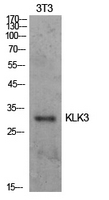![Prostate Specific Antigen (PSA)(3E6), CF405S conjugate, 0.1mg/mL [26628-22-8] Prostate Specific Antigen (PSA)(3E6), CF405S conjugate, 0.1mg/mL [26628-22-8]](https://biotium.com/wp-content/uploads/2021/02/view_image-4.jpeg)
Prostate Specific Antigen (PSA)(3E6), CF405S conjugate, 0.1mg/mL [26628-22-8]
BNC041777
ApplicationsImmunoHistoChemistry, ImmunoHistoChemistry Paraffin
Product group Antibodies
TargetKLK3
Overview
- SupplierBiotium
- Product NameProstate Specific Antigen (PSA)(3E6), CF405S conjugate, 0.1mg/mL [26628-22-8]
- Delivery Days Customer9
- ApplicationsImmunoHistoChemistry, ImmunoHistoChemistry Paraffin
- CertificationResearch Use Only
- ClonalityMonoclonal
- Clone ID#3E6
- Concentration0.1 mg/ml
- ConjugateOther Conjugate
- Gene ID354
- Target nameKLK3
- Target descriptionkallikrein related peptidase 3
- Target synonymsAPS, KLK2A1, PSA, hK3, prostate-specific antigen, P-30 antigen, gamma-seminoprotein, kallikrein-3, semenogelase, seminin
- HostMouse
- IsotypeIgG1
- Protein IDP07288
- Protein NameProstate-specific antigen
- Scientific DescriptionRecognizes a single protein of 33-34 kDa, identified as the prostate specific antigen (PSA). This MAb is highly specific to PSA and stains prostatic secretory and ductal epithelium in both normal and neoplastic tissues. PSA is a chymotrypsin-like serine protease (kallikrein family) exclusively produced by the prostate epithelium, and abundant in seminal fluid. PSA can be detected in the sera of patients with prostatic carcinoma. It is predominantly complexed to a liver-derived serine protease inhibitor, alpha-1-antichymotrypsin (ACT). A higher proportion of serum PSA is complexed to ACT in prostate cancer than in benign prostate hyperplasia. This MAb makes an excellent pair with MAb A67-B/E3 for PSA tests. Primary antibodies are available purified, or with a selection of fluorescent CF® Dyes and other labels. CF® Dyes offer exceptional brightness and photostability. Note: Conjugates of blue fluorescent dyes like CF®405S and CF®405M are not recommended for detecting low abundance targets, because blue dyes have lower fluorescence and can give higher non-specific background than other dye colors.
- SourceAnimal
- Storage Instruction2°C to 8°C
- UNSPSC12352203






